Students who are in search of 2nd PUC English Grammar Notes Note Making pdf. First check in which chapter you are lagging and then Download Karnataka Board 2nd PUC English Textbook Answers Chapter Wise. Students can build self confidence by solving the Answers with the help of Karnataka State Board 2nd PUC. English is the scoring subject if you improve your grammar skills. Because most of the students will lose marks by writing grammar mistakes. So, we suggest you to Download Karnataka State Board 2nd PUC English Answers according to the chapters.
Karnataka 2nd PUC English Grammar Notes Note Making
Read the following passage and make notes by drawing and filling the boxes given below: The term ‘resource is derived from French, and it means tools. Natural resources are the raw materials and the sources of energy present on the earth. They include the deposits of coal, crude oil, and natural gas. The basic needs of our existence such as air, water and soil, which gives us food, also belong to resources that we may be able to exploit in future.
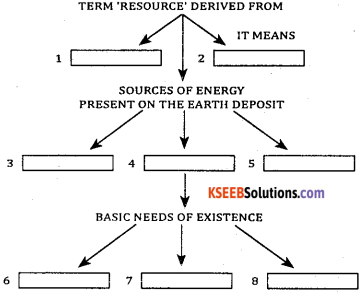
Answer:
1. French
2. Tools
3. Coal
4. Crude oil
5. Natural gas
6. Air
7. Water
8. Soil.
2. Read the following passage and make notes by drawing and filling the boxes given below: The word ‘Oceans’implies the large water bodies of the world, namely the Pacific, Atlantic, Indian and Arctic, as well as the Antarctic ocean where we find icebergs. Smaller seas are separated from the oceans by island chains or under-water ridges which are called ‘bordering seas. These include: ‘The North Sea, the Baltic sea, the Mediterranean sea and the Caribbean sea? The bordering seas and the oceans have some common features: both contain salty water and restless sea beds.
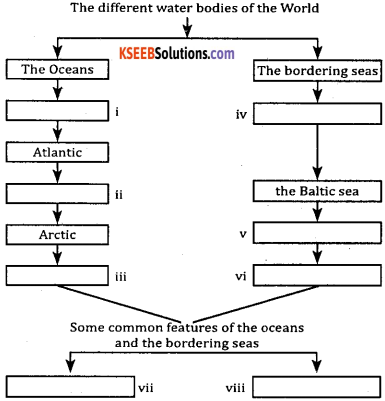
Answer:
i. Pacific
ii. Indian
iii. Antarctic
iv. The North sea
v. The Mediterranean sea
vi. The Caribbean sea
vii. salty water
viii. restless sea beds.
3. Read the following passage and make notes by drawing and filling the boxes given below: Paper was discovered in China by an official named Tsai Lun. He discovered it in about AD 105. Until then most of the documents in China had been written on parchment and Vellum. Parchment was made from the skin of goats or sheep. Vellum was made from the skin of a calf. A number of animals had to be killed to make a book. However, now we do not have to do that. We use wood pulp, at present, for making paper.
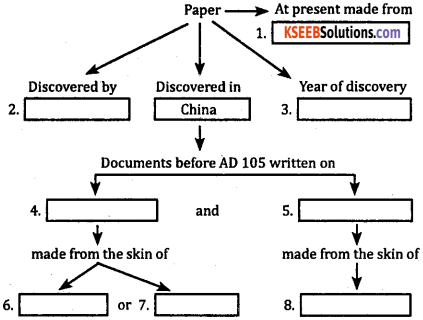
Answer:
1. Wood pulp
2. Tsai Lun
3. AD 105
4. parchment
5. vellum
6. goats
7. sheep
8. calf.
4. Read the following passage and make notes by drawing and filling the boxes given below: Blood is the essential red fluid that is pumped by the heart through the circulatory system. It is complex in its composition and functions. Blood has two main constituents – the cells, comprising about 45% and the plasma comprising about 55%. The blood cells comprise three main types – red blood cells, white blood cells and platelets. Each type of cell has its own function in the body. The plasma is a complex colorless solution and it contains 90% of water. It also has fibrinogen, the protein that aids in clotting.
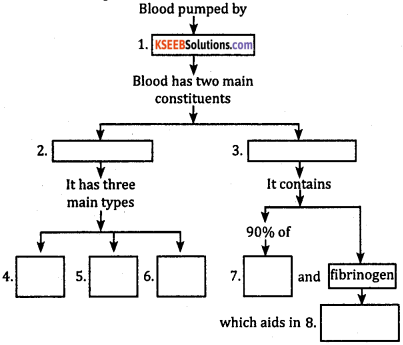
Answer:
1. heart
2. Cells.
3. Plasma
4. Red blood cells
5. White blood cells
6. Platelets
7. water
8. clotting.
5. Read the following passage and make notes by drawing and filling the boxes given below: Vertebrate animals can be either warm-blooded or cold-blooded. A cold-blooded animal cannot maintain constant body temperature. The temperature of its body is determined by the outside surroundings. Cold-blooded animals are also called ‘ectothermic, which means outside heat. They are reptiles, amphibians and fishes. Warm-blooded animals are able to regulate their internal temperature. They have fur and feather to keep them warm. They are also called ‘endothermic’ meaning heat inside. They are birds and mammals.

Answer:
i. warm-blooded
ii. cold-blooded
iii. ectothermic
iv. reptiles
v. amphibians
vi. fishes
vii. endothermic
viii. mammals.
6. Read the following passage and make notes by drawing and filling the boxes given below: Algae are living organisms that are found all over the world. There are 27,000 different species of algae. They belong to a group of living things called protists. Some algae, such as sea-weed, look like plants. However, algae are neither plants nor animals. Algae are very important because, they make much of earth’s oxygen which humans and animals need to breathe. They make their own food through photosynthesis. Algae are commonly found in water but some species live in soil, leaves, wood and stones. They even grow on animals such as turtles and polar bear. Water: animals depend on algae for food. The algae called kelp can reach.
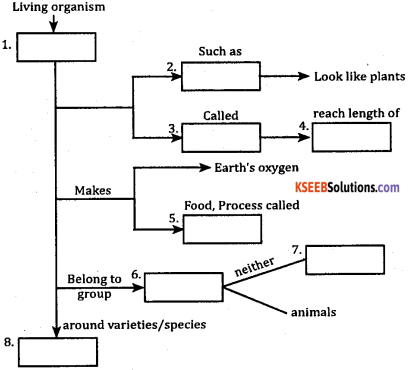
Answer:
1. Algae
2. Sea-weed
3. Kelp
4. 200 feet
5. photosynthesis
6. Protists
7. plants
8. 27,000.
7. Read the following passage and make notes by drawing and filling the boxes given below: Krishnadevaraya ruled the Vijayanagara Empire. He gave good governance during his regime. Gold, silver and diamond were sold on the streets of Vijayanagara. He respected men and women equally. In his court, there was a clown called Tenali Rama who was known for his wit.
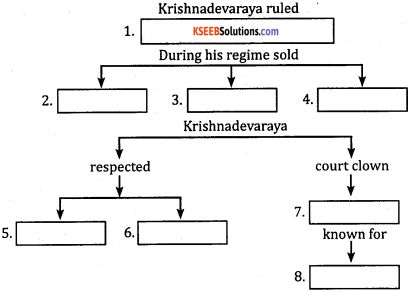
Answer:
1. Vijayanagara Empire
2. Gold
3. Silver
4. Diamond
5. men
6. women
7. Tenali Rama
8. wit.
8. Read the following passage and make notes by drawing and filling the boxes given below:
A rickshaw puller is a common sight in India. He can be seen standing at public places like bus stands, railway stations and road crossings waiting for passengers. He appears miserable and weak. He is not treated well by the general public and is generally, overworked and unpaid. He is generally hated, humiliated by everyone.
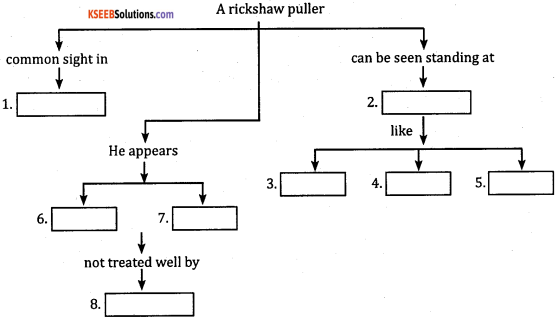
Answer:
1. India –
2. public places
3. bus stands
4. railway stations
5. road crossings
6. miserable
7. weak
8. general public.
9. Read the following passage and make notes by drawing and filling the boxes given below: The most complex of all tissues is the bone. It serves as a framework, giving form to the body, protecting the vital organs and bearing weight and strain. It is also a storehouse for calcium, which is supplied to the blood.
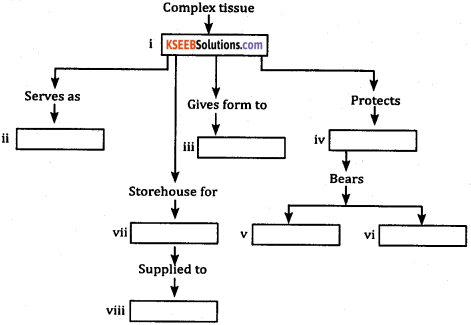
Answer:
i. bone
ii. a framework
iii. the body
iv. vital organs
v. weight
vi. strain
vii. calcium
viii. the blood.
10. Read the following passage and make notes by drawing and filling the boxes given below: Books are a vital record of human life and achievement. They store the thoughts, beliefs and experiences of individuals and societies. There are many kinds of books: religious works, fiction? and non-fiction. The Chinese invented printing in the 9th century; it arrived in Europe in the 15th century. Printing made it possible to mass-produce books and knowledge was spread more widely. Today, publishing is a global industry.
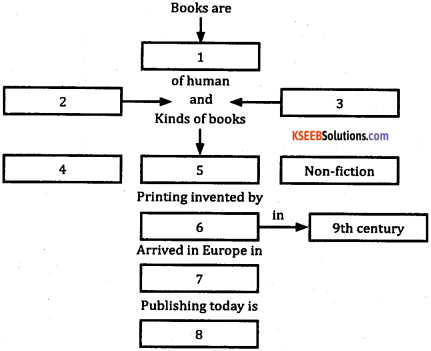
Answer:
1. a vital record
2. life
3. achievement
4. Religious works
5. Fiction
6. the Chinese
7. the 15th century
8. a global industry.
11. Read the following passage and make notes by drawing and filling the boxes given below: Ten thousand years ago, the first farmers began to grow crops and breed animals for food. Earlier the nomadic hunter-gatherers fed on berries, plants and wild beasts. With the emergence of farming, they settled in one place giving rise to the world’s earliest civilizations in Mesopotamia, Egypt, India and China. In the 18th century, a so-called agricultural revolution led to significant changes making farming more mechanized.
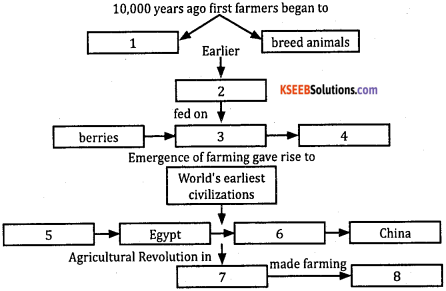
Answer:
1. grow crops
2. the nomadic hunter-gatherers
3. plants
4. wild beasts
5. Mesopotamia
6. India
7. the 18th century
8. more mechanised.
12. Read the following passage and make notes by drawing and filling the boxes given below: The process of buying and selling goods and services is called trade. There are two types of trade: internal trade and international trade. The trade which is carried on within a nation is called internal trade. It is also known as home trade or domestic trade. International trade is trade among different nations of the world. It is also called foreign trade. It is considered as engine of growth.
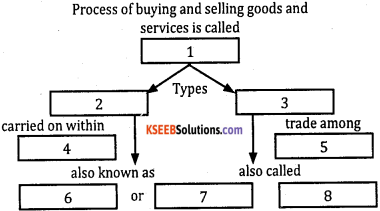
Answer:
1. trade
2. internal trade
3. international trade
4. a nation
5. nations
6. home trade
7. domestic trade
8. foreign trade.
13. Read the following passage and make notes by drawing and filling the boxes given below:
Hundreds of islands lie in the Caribbean Sea, east of the United States of America and stretch west into the Atlantic Ocean. These Caribbean islands, also known as the West Indies, take their name from the Caribs, the original inhabitants of the region until the Spanish arrived in 1492.
The inhabitants of most islands today are descendants of African slaves brought to work in plantations between the 16th and 19th centuries. The islands have a tropical climate, turquoise waters, and fine beaches and have developed booming tourist industry. Many people here depend on farming for their living.
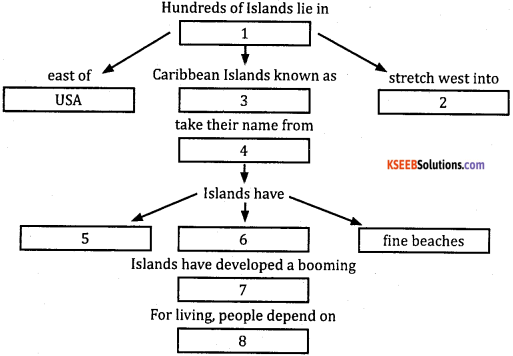
Answer:
1. the Caribbean Sea
2. the Atlantic Ocean
3. the West Indies
4. the Caribs
5. tropical climate
6. turquoise waters
7. tourist industry
8. farming.
14. Read the following passage and make notes by drawing and filling the boxes given below:
Our earliest ancestors, the hominids, lived in Africa as they evolved into an upright posture and learned to make tools, around 10,00,000 years ago. They became known as modern people or Homo sapiens. These people are sometimes called prehistoric because they lived long before recorded history. From fossil evidence, we know they found food by gathering and hunting, made simple clothes and built shelters out of local materials. People lived like this for thousands of years. Around 9000 B.C., for the first time, people in West Asia started to produce their food by farming.
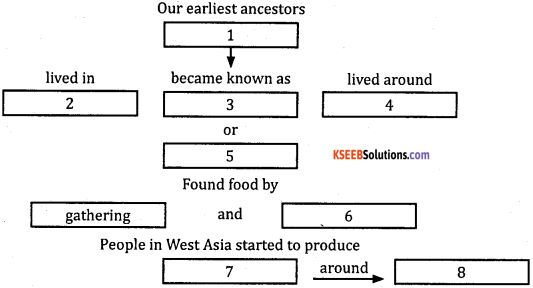
Answer:
1. the hominids
2. Africa
3. modern people
4. 10,00,000 years ago
5. Homo sapiens
6. hunting
7. food
8. 9000 B.C.
15. Read the following passage and make notes by drawing and filling the boxes given below: South America’s habitats include tropical forests of the north, grasslands of the centre and South, tributaries of the Amazon, the Andes Mountains in the west, deserts fringing the west coast, and wetlands of Brazil. South America is rich in wildlife, much of it found in the rain forests. The distinctive animals of South America, including anteaters, sloths, opossums and new world monkeys, evolved when South America was separated from North America and got isolated from the rest of the world.
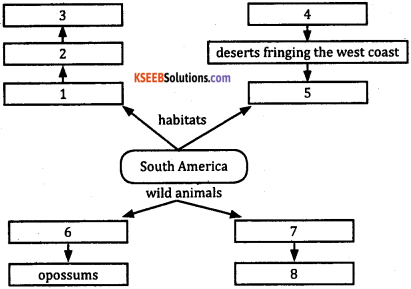
Answer:
1. tropical forests of the north
2. grasslands of the centre and south
3. tributaries of the Amazon
4. the Andes Mountains in the west
5. wetlands of Brazil
6. anteaters
7. sloths
8. new world monkeys.
16. Read the following passage and make notes by drawing and filling the boxes given below: Mongooses belong to a group of carnivorous mammals that also include civets, genets, the fossae and binturong (or bear-cat). Mongooses live in southern Europe, southern Asia and much of Africa. The banded and dwarf mongooses live in family groups, and are very sociable. Each one of them has a special duty and enables the group to work together harmoniously. Female mongooses remain close to their nest and look after the young, while males go hunting for food. These mongooses live in burrows, which they dig themselves or take over from other animals such as termites.
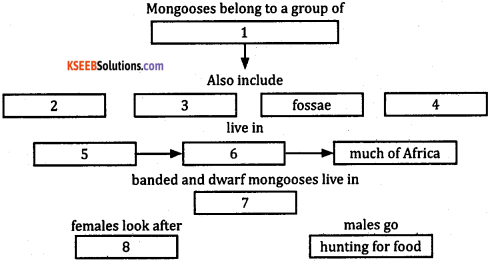
Answer:
1. carnivorous mammals
2. civets
3. genets
4. binturong
5. southern Europe.
6. southern Asia
7. family groups
8. the young.
17. Read the following passage and make notes by drawing and filling the boxes given below: There are three components of population growth. They are births, deaths and migration. The rates of these components are measured per 1000 people per year and they vary from one country to another. The average birth rate of the world is 19.14. Niger has the highest birth rate in the world with 51.76 births and Japan has the lowest with 7.64. The average death rate of the world is 8.37. Sierra Leone ranks first with 18 deaths and Qatar has the least death rate with just 1.53.
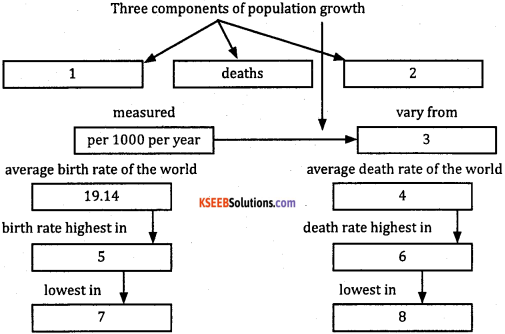
Answer:
1. births
2. migration
3. one country to another
4. 8.37
5. Niger
6. Sierra Leone
7. Japan
8. Qatar.
18. Read the following passage and make notes by drawing and filling the boxes given below: Human Development Index has three dimensions. The countries of the world are ranked based on their performance in the areas of health, education and access to resources. In order to measure the performance in health, life expectancy is taken into account whereas to measure the performance in education, rate of literacy is considered. The standard of living is appraised while measuring the performance in respect of access to resources. It is measured in terms of purchasing power in US dollars.
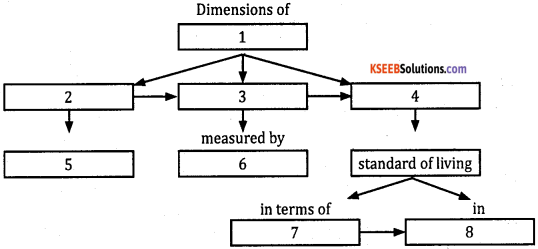
Answer:
1. Human Development
2. health
3. education
4.access to resources
5. life expectancy
6. rate of literacy
7. purchasing power
8. US dollars.
19. Read the following passage and make notes by drawing and filling the boxes given below: Drip irrigation system was developed in Israel. This system uses a small amount of water for irrigating crops. It is best suited in areas that face acute scarcity of water. It was introduced in India in the 1970s. It is widely used by farmers in Rajasthan, Maharashtra, Karnataka and Tamil Nadu. It is mainly used for coconut, grape, vegetables and plantation crops. It is estimated that 6.3 lakh hectares of land in India is irrigated under this system.
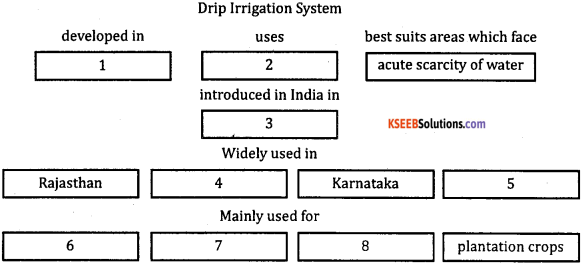
Answer:
1. Israel
2. small amount of water for irrigation
3. 1970s
4. Maharashtra
5. Tamil Nadu
6. coconut
7. grape
8. vegetables.
20. Read the following passage and make notes by drawing and filling the boxes given below:
There are three methods of rice cultivation. They are broadcasting, drilling and transplanting. The broadcasting method involves scattering of seeds by hand and it is practiced in less fertile hilly areas. In drilling method, seeds are drilled into the soil. This method is confined to peninsular India. The transplanting method uses seedlings grown in seed beds for four weeks. It requires abundant supply of labor and water but gives higher yields.
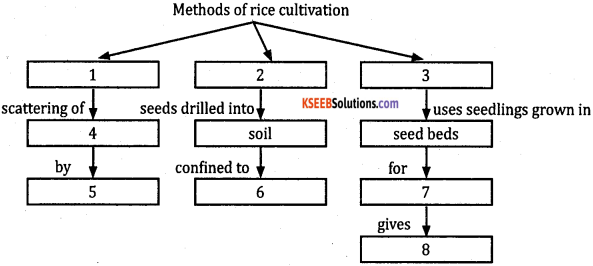
Answer:
1. broadcasting
2. drilling
3. transplanting
4. seeds
5. hand
6. peninsular India
7. four weeks
8. higher yields.
21. Read the following passage and make notes by drawing and filling the boxes given below:
Coffee is a tropical plant. It is the second most popular beverage crop of India, the first being tea. Coffee plant was first introduced in India by a Muslim Fakir called Bababudan Sahib. He brought some seeds of coffee from Mecca during the 17th century. He planted them in the Chandragiri hills presently in the Chikmagalur district. The cultivation of coffee crops started in the 19th century on a large scale. Gradually it spread to Tamil Nadu, Kerala and other parts of our country.
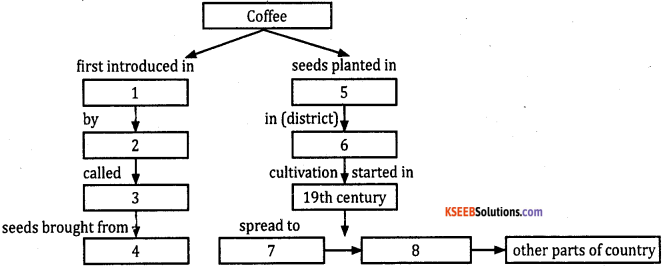
Answer:
1. India
2. A Muslim Fakir
3. Bababudan Sahib
4. Mecca
5. Chandragiri hills
6. Chikmagalur
7. Tamil Nadu
8. Kerala.
22. Read the following passage and make notes by drawing and filling the boxes given below: Energy is the primary input in the production of goods and services. The wheels of progress move with the flow of energy. On the basis of their nature, the sources of energy are of two types: conventional and non-conventional. Coal, petroleum, natural gas and electricity are the conventional energy sources. These are limited and exhaustible in nature. The sun, wind, tides, geothermal energy and bio-gas are the sources of non-conventional energy. These sources are renewable in nature.
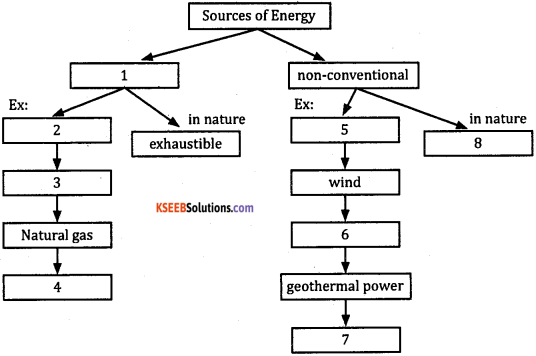
Answer:
1. conventional
2. coal
3. petroleum
4. electricity
5. sun
6. tides
7. bio-gas
8. renewable
The main aim is to share the knowledge and help the students of 2nd PUC to secure the best score in their final exams. Use the concepts of Karnataka 2nd PUC English Answers Grammar Notes Note Making in Real time to enhance your skills. If you have any doubts you can post your comments in the comment section, We will clarify your doubts as soon as possible without any delay.